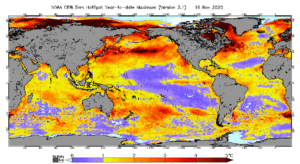
2020 will be another record year for coral reef bleaching, but there will be almost no field documentation of its global extent and impacts because the Covid epidemic has put a near complete halt to diving.
As usual, global news media reported bleaching only in the Great Barrier Reef. Tourism commercial divers had already long stopped reporting bleaching way before Covid because it happens nearly every year now and is “bad for business” so they didn’t want customers to know.
Fortunately, we have been able to predict bleaching accurately for 30 years using the Coral Bleaching HotSpot method (Goreau 1990, Goreau & Hayes 1994). Here is the 2020 to date maximum Bleaching Hot Spot intensity from the NOAA coral bleaching HotSpot site.
You can see that very few coral reef areas in the world escaped serious thermal stress in 2020!
GCRA first predicted the start and finish of bleaching early this year in the Great Barrier Reef, whose serious impacts were documented by local divers prior to Covid shutdown.
Bleaching then followed immediately in southern Indonesia, especially Bali and Lombok, with mortality affecting many reefs still not yet recovered fully from the severe bleaching event in 2016. In contrast Biorock reefs recovered rapidly from bleaching with very little mortality in Bali and in Lombok (below) both in 2016 and 2020.
Following the Australia and Indonesia Coral Bleaching HotSpots, severe bleaching HotSpots developed in the Philippines, the Gulf of Thailand, and westernmost India. Biorock reefs installed in January 2020 in Kachchh, Gujarat, India, suffered severe bleaching but corals on Biorock remained healthy and feeding, survived the event, and soon recovered, unlike control corals. Details will be posted by Dr. Chowdula Satyanarayana of the Zoological Survey of India.
Bleaching HotSpots then developed in the Western Pacific, covering South China, Taiwan (where severe bleaching was the worst since 1998), Okinawa and the Ryukyu Islands, Palau, Guam, the Mariana Islands, and the Federated States of Micronesia. Bleaching was very severe and prolonged in these areas, and severe coral mortality is certain.
Other than Taiwan the only place where we have had reports are from Oroluk, a remote uninhabited atoll in Micronesia, where vast areas of pristine reef were found dead by GCRA’s colleague Erik Hagberg:
“I did see massive bleaching on Oroluk. A particular channel which we used to fish that was once all live coral has all died out and turned to algal growth. Fish stocks in that area seemed to have dramatically declined. Over a mile stretch of prime reef and fish habitat gone. I also saw signs of spot bleaching everywhere we went but the long continuous patches of reef that bleached out were the greatest surprise”.
This can only be due to high temperature, as there are no other human pressures on these reefs.
In October bleaching conditions developed across the entire Caribbean Basin but fortunately waters cooled before severe bleaching could happen except in Aruba, Bonaire, Curaçao, and Los Roques, Venezuela, with mild bleaching reported in Mexico and Belize. Caribbean waters then began to cool down as the result of another extreme climate event, the record number of hurricanes in the Caribbean in 2020, and the record long hurricane season.
The hurricane season, which always ended in October, has been greatly lengthened by global warming. Hurricane Charlie blew the roof off our house when I was a baby, and like all Jamaican children have for hundreds of years, I learned the hurricane season song in elementary school:
June, too soonI
July, stand by!
August, it must!
September, remember!
October, all over!
That was the end of the song because we never had hurricanes in November! All of November 2020 we have had one hurricane form right after another, as an increasingly hot ocean increases atmospheric humidity, rain, wind, and waves. Here in Jamaica, 2020 has been nearly constantly too rough for us to dive and grow back our dying coral reefs.
These increasingly extreme events strongly reinforce the long-known prediction that hurricanes will become much stronger as the water warms (Emanuel, 1987), fueling extreme hurricanes which will devastate coral reefs through huge waves, and with mud and fresh water from flooding.
The Coral Bleaching HotSpot (Goreau & Hayes, 1994) is a general measure not only of coral bleaching, and potential hurricane formation, but of all extreme marine high temperature stress events. This makes it invaluable for documenting all marine heat waves (which drive CO2 and oxygen out of the ocean and into the atmosphere) and the massive melting of Arctic Ice in 2020, which will cause even more rapid global warming in the near future.
In short, 2020 was yet another severe world-wide bleaching year. There has been a strong La Niña event all of 2020, so average global ocean temperatures are lower than they will be in the next El Niño event, which now seems about to start soon. Coral mortality could be even worse in 2021 and coming years as El Niño warming adds to global warming.
Biorock technology has repeatedly been shown to be the only method that saves corals from dying in severe bleaching events and recovering rapidly. In 2020 GCRA’s Biorock Indonesia colleagues observed this in Bali and in Lombok, Indonesia, and Gujarat, India (forthcoming).
Since coral reefs passed their global high temperature tipping point in the 1980s most corals have died, and the survivors await the next record hot year.
It is now critically urgent to establish Biorock Coral Arks to save corals, coral reefs, and their unequalled ecosystem services in every coral region before mass extinction of reef ecosystems occurs from heat stroke.